Reverse Engineering Latest ChatGPT Memory Feature (And Building Your Own)


In this analysis, we break down OpenAI's new memory system and provide a technical blueprint for implementing similar capabilities, without requiring programming expertise.
New to AI Memory Systems?
If you're new to the concept of memory in AI agents, we recommend first reading our foundational article Beyond Stateless: How Memory Makes AI Agents Truly Intelligent, which explains the fundamental concepts and importance of memory in AI systems.
OpenAI's Memory Evolution
Last week, OpenAI announced a significant upgrade to ChatGPT's memory capabilities. The enhanced system now allows ChatGPT to reference a user's entire conversation history across multiple sessions—transforming it from a stateless responder into a more personalized assistant that evolves with ongoing interactions.
This update represents a major advancement in how commercial AI systems handle persistent user context, pointing toward what Sam Altman described as "AI systems that get to know you over your life, and become extremely useful and personalized."
Key Components of OpenAI's Memory Architecture
Let's break down the likely architecture behind OpenAI's implementation:
System Architecture
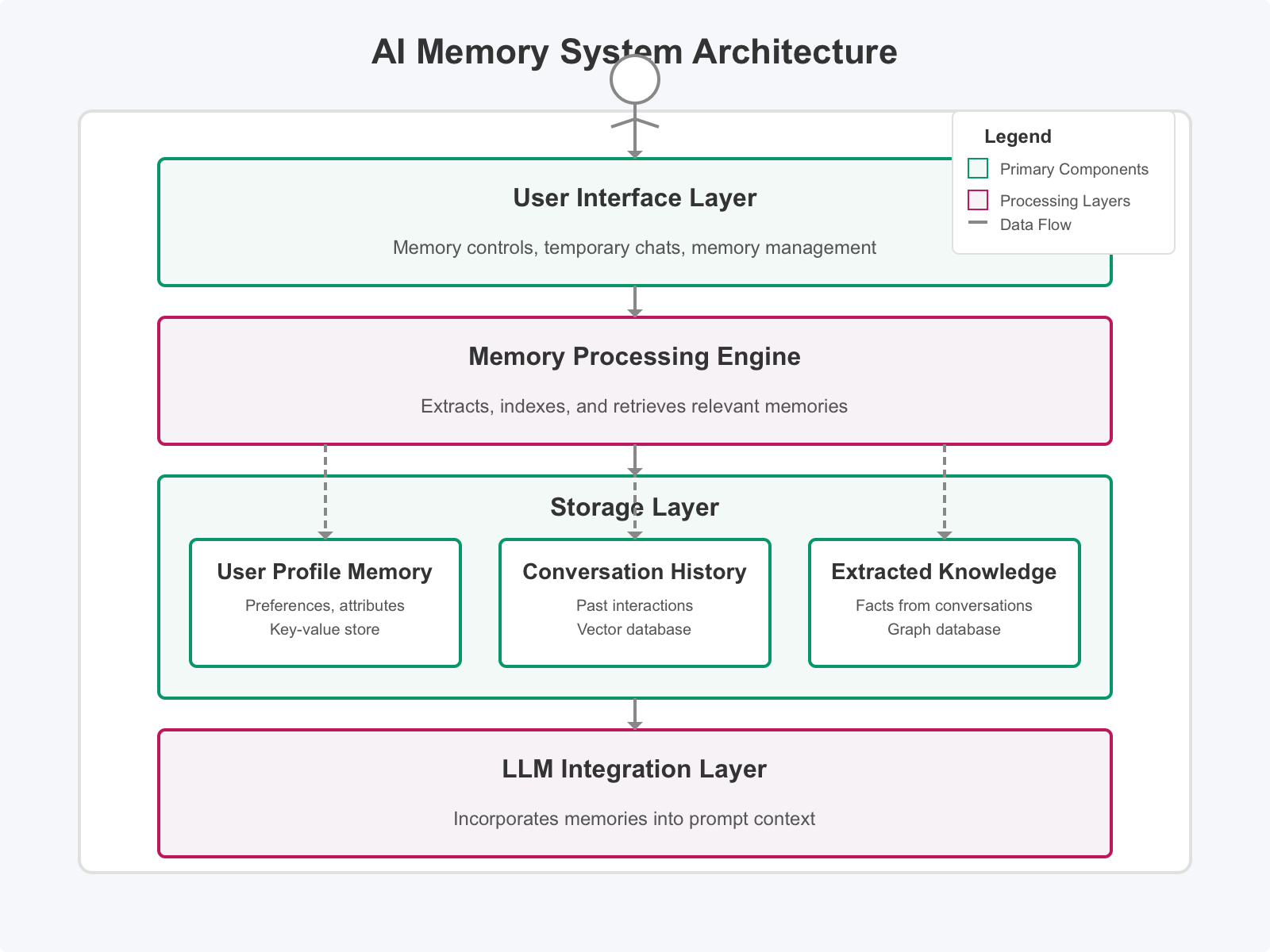
Figure 1: Memory System Architecture
The architecture consists of four primary components working together as a cohesive system. At the top level, the User Interface Layer provides controls for memory visibility, temporary chats, and memory management—giving users transparency and control over what's remembered. Below that, the Memory Processing Engine works continuously to extract, index, and retrieve relevant memories from conversations. This connects to the Storage Layer, which maintains different types of memory with varying levels of persistence. Finally, the LLM Integration Layer incorporates these memories into the prompt context, ensuring the AI has access to the right information at the right time.
Memory Types and Storage
OpenAI's system likely implements multiple types of memory working in concert:
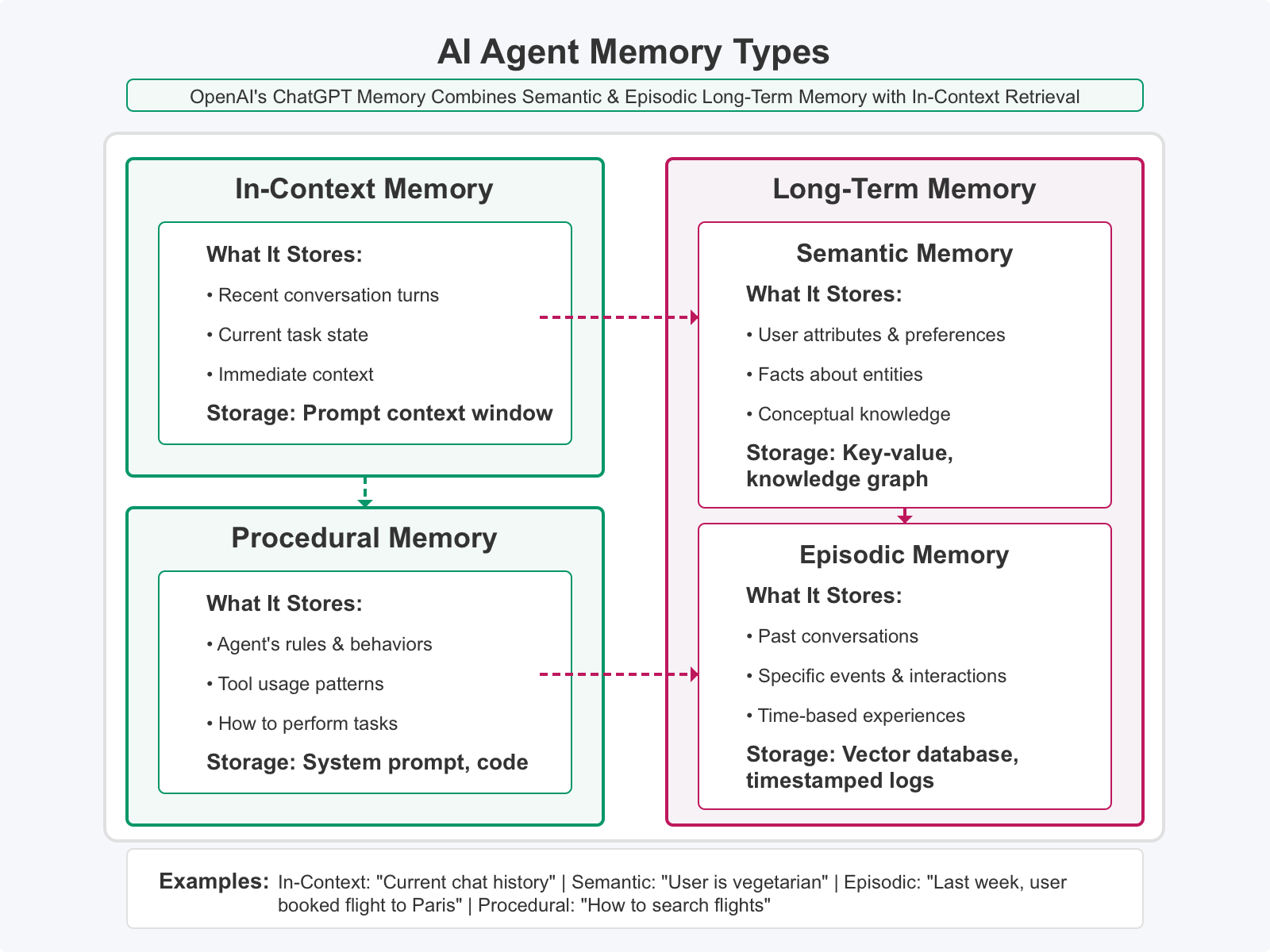
Figure 2: Memory Types and Relationships
User Profile Memory serves as the foundation, storing persistent facts about the user including preferences, demographic information, and important facts that remain relevant across all conversations. Complementing this, Conversation History maintains complete logs of past interactions, providing a rich source of context for future exchanges. The system also builds Extracted Knowledge by transforming unstructured conversation data into structured information. All of these feed into the Active Context—the currently relevant memories loaded specifically for each session, carefully selected to enhance the current exchange.
The Memory Interaction Flow
When a user interacts with a memory-enabled system like ChatGPT, memory flows through the system in a sophisticated sequence:
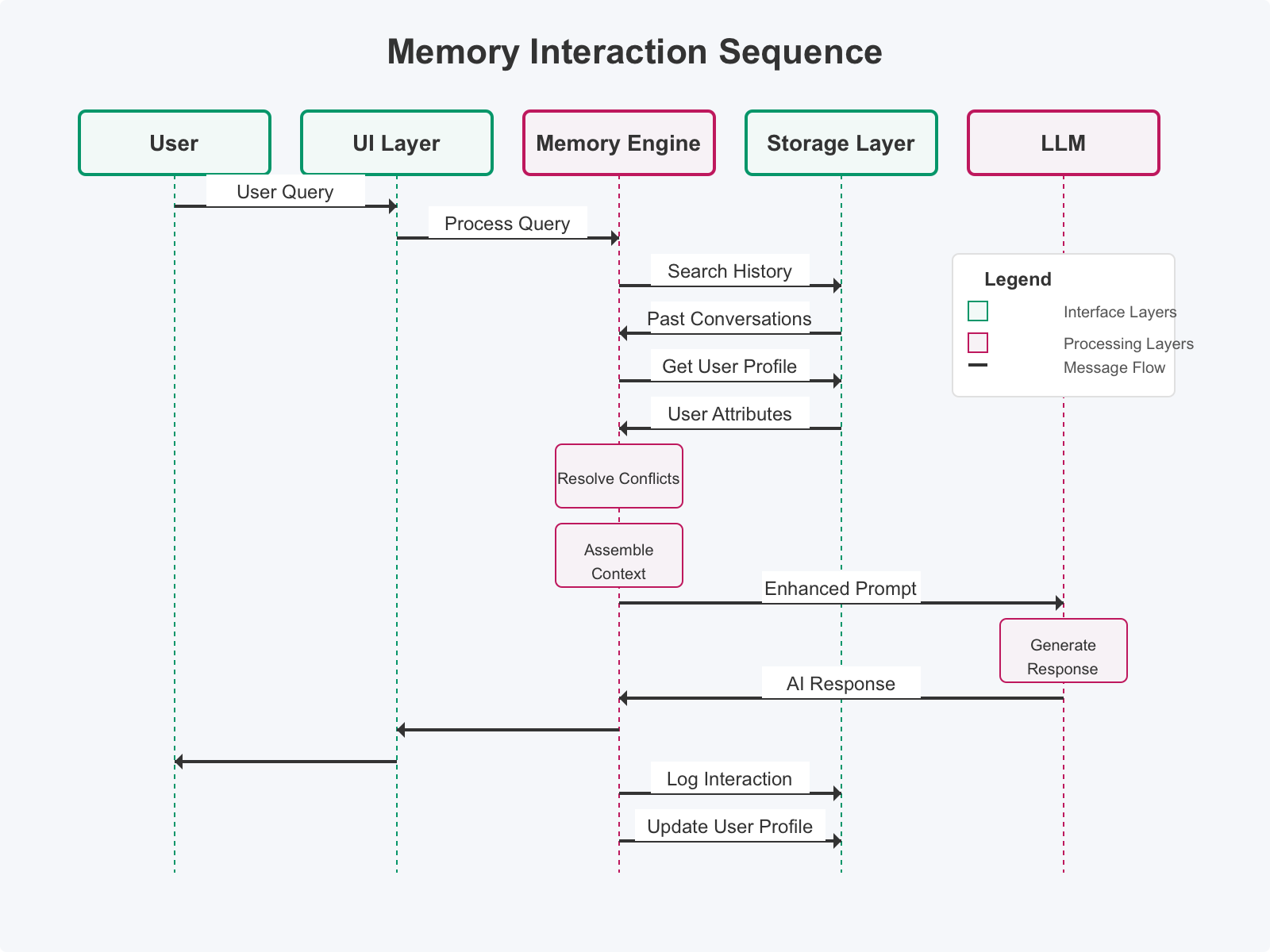
Figure 3: Memory Sequence Diagram
The process begins when a user sends a message, triggering the memory retrieval phase. The system immediately searches conversation history for relevant past interactions while simultaneously retrieving user profile information. It also works to identify any conflicting or outdated information that might need resolution. Next comes context assembly, where relevant memories are thoughtfully formatted and added to the prompt. The LLM then generates a response using this enhanced context, creating a more personalized interaction. After the exchange, the system updates its memory by logging the new conversation turn, updating the user profile with any new information, and resolving contradictions with existing memories.
Building Your Own Memory System
Now, let's explore how you can implement similar memory capabilities in your own AI agent system, even without deep programming expertise.
Designing Your Memory Architecture
The foundation of any effective memory system is a well-designed architecture. We recommend a three-tier approach that balances immediate context with long-term persistence:

Figure 4: Three-Tier Memory Architecture
The first tier, Short-Term Context Memory, maintains the immediate conversation flow. It typically contains the last 5-10 message turns kept directly in the prompt, lasting only for the current session. This gives your AI the immediate context needed for coherent exchanges.
The second tier, User Profile Memory, maintains persistent information about your users. This includes preferences, demographics, and important facts stored in a structured database that persists indefinitely until deletion. This profile grows richer with each interaction, allowing your AI to understand users better over time.
The third tier, Episodic Long-Term Memory, stores complete conversation history for retrieval. All past interactions are saved with timestamps and metadata in a vector database with search capabilities. These memories persist indefinitely, with optional archiving for older content, creating a rich history the AI can reference when needed.
Memory Management Workflows
The effectiveness of your memory system depends on well-designed workflows for storing and retrieving information:
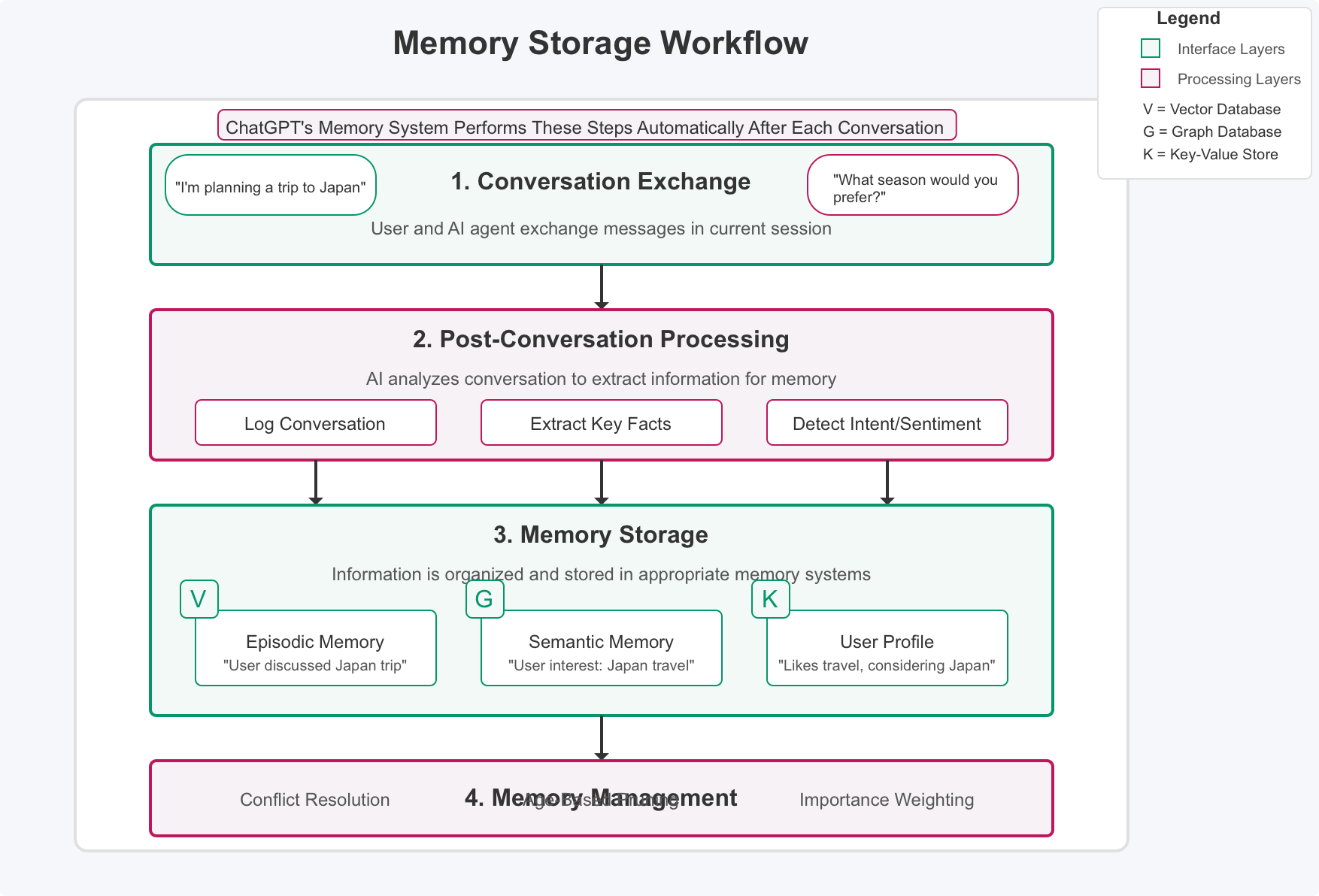
Figure 5: Memory Storage Process
The storage workflow begins when users and AI exchange messages. After each interaction, the system performs essential post-processing. It logs the full conversation to episodic memory while extracting key facts and preferences. These insights update the user profile with new information, with special attention to flagging contradictions with existing memories. This continuous refinement ensures the memory stays current and accurate over time.

Figure 6: Memory Retrieval Process
The retrieval workflow activates when a user sends a message. The system first pre-processes the query by searching episodic memory for relevant past conversations, retrieving current user profile information, and selecting the most relevant memories based on query context. It then assembles a comprehensive prompt combining short-term context from recent messages, relevant episodic memories, and user profile attributes. With this enriched context, the AI generates a response that feels informed by the complete relationship history.
Technical Implementation Options
You don't need to build a memory system from scratch. Several existing technologies can serve as building blocks for your implementation.
Implementation Tip
Start with a simple memory architecture and gradually expand as your needs grow. Many projects can begin with just vector storage and basic retrieval before adding more complex features.
Vector Database Options
Pinecone
Cloud-based vector database with simple API that scales effortlessly. Ideal for production deployments with high reliability requirements.
Weaviate
Open-source vector search engine with rich semantic capabilities. Offers more flexibility for custom implementations.
Chroma
Lightweight embedding database designed specifically for retrieval-augmented generation. Perfect for smaller projects and quick prototyping.
Memory Management Frameworks
Mem0
Provides hybrid storage for user and agent memories, combining different storage types for optimal performance.
MemGPT/Letta
Offers hierarchical memory with tool-based access, giving AI agents more control over their memory systems.
LangChain Memory
Includes conversation buffers and summary memory components that integrate smoothly with existing LangChain applications.
Privacy and Control Considerations
Based on OpenAI's implementation, your memory system should incorporate robust privacy controls:
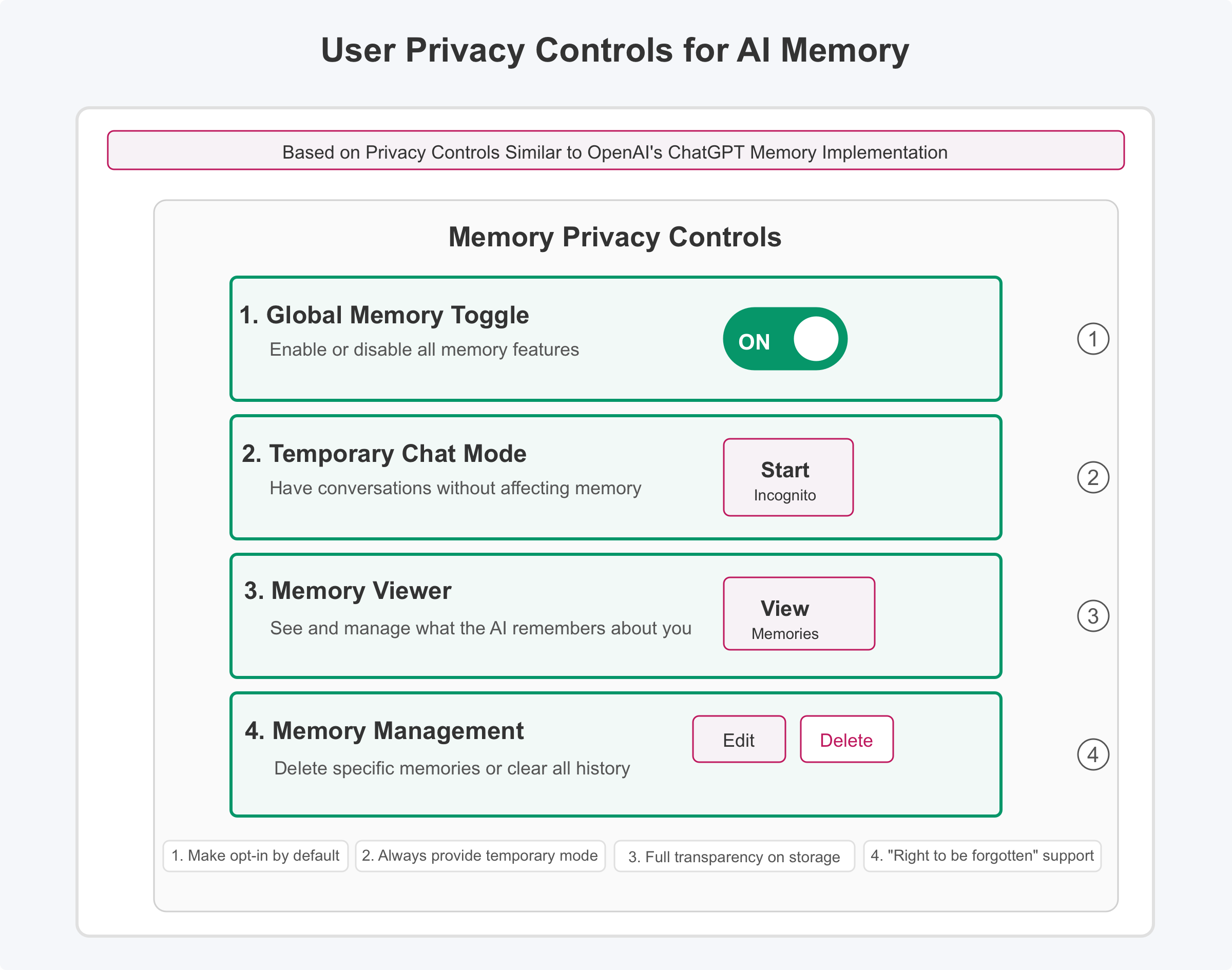
Figure 7: User Privacy Controls
Effective memory systems balance utility with privacy. Visibility controls allow users to see what information you're storing about them, creating transparency that builds trust. Complementing this, deletion options enable users to remove specific memories or their entire history when desired. Temporary modes provide "incognito" sessions that don't affect memory, perfect for sensitive topics or exploratory conversations. All these features should be built on strong consent mechanisms, with memory storage ideally being opt-in by default. Finally, practice data minimization by extracting only information that genuinely improves user experiences, avoiding unnecessary data collection.
Performance Optimization Strategies
Scaling Challenges
As your memory system grows, performance can degrade without proper optimization. A system that works perfectly with 100 memories might struggle with 10,000 or more.
As your system accumulates memories over time, performance optimization becomes increasingly important:
Tiered Storage Strategy
Balance performance and cost with a multi-tiered approach:
- Hot tier: Recent and frequently accessed memories in fast storage
- Warm tier: Older but potentially relevant memories
- Cold tier: Archived memories rarely accessed
This approach ensures critical memories are always quickly accessible while optimizing resource allocation for less frequently used data.
Memory Consolidation Strategy
Manage growing data volumes with intelligent consolidation:
- Periodic summarization of older conversations to distill their essence
- Extraction of enduring facts from ephemeral conversations
- Resolution of conflicting information across memory stores
These techniques maintain the most valuable information while reducing overall storage requirements.
Retrieval Optimization Strategy
Ensure responsive performance as your memory grows:
- Pre-computation of embedding vectors during storage
- Metadata filtering before running expensive vector searches
- Caching of frequently accessed memories to reduce database load
These optimizations dramatically improve response times, especially in systems with large memory stores.
Real-World Implementation Scenarios
Industry Applications
Memory systems can be customized for specific industries, with each implementation prioritizing different types of information based on domain needs.
Let's examine how different organizations might implement memory in practical applications:
E-commerce Customer Support
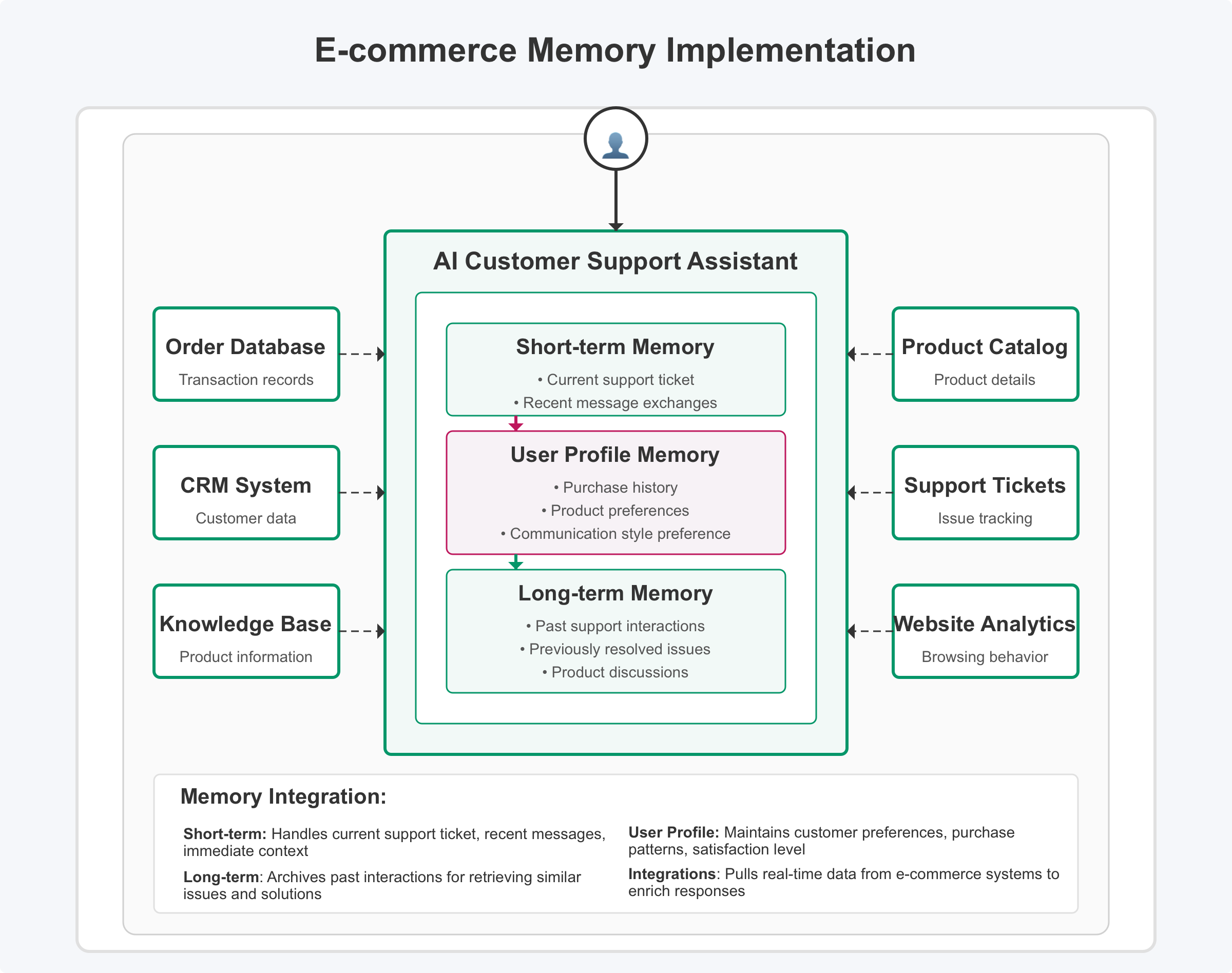
Figure 9: E-commerce Memory Integration
In an e-commerce customer support context, short-term memory holds recent order issues and details about the current support ticket, providing immediate context for the conversation. The user profile expands this with purchase history, product preferences, and support history, creating a comprehensive customer view. Long-term memory maintains previous issue resolutions and product discussions, allowing agents to reference past interactions when similar issues arise. This memory architecture integrates with existing systems including order databases, CRM systems, and knowledge bases, creating a seamlessly connected support experience.
Healthcare Assistant

Figure 10: Healthcare Memory Integration
For healthcare applications, short-term memory focuses on current symptoms and immediate health concerns, helping assistants address pressing patient needs. The patient profile contains critical information including medical history, medications, allergies, and chronic conditions. Long-term memory maintains records of previous consultations, tracks treatment adherence, and monitors health trends over time. These memory components integrate with healthcare systems including EHR platforms, medication databases, and symptom trackers, ensuring the assistant has a complete picture of patient health while maintaining compliance with healthcare regulations.
Conclusion: The Future of AI Memory Systems
Key Takeaway
OpenAI's memory upgrade validates what we've discussed throughout our memory series: truly intelligent AI agents require persistent, evolving memory to deliver personalized experiences.
The technical architecture we've outlined provides a blueprint for building your own memory-enabled system. You don't need to be a programmer to implement these concepts—many tools and frameworks now offer pre-built components you can integrate using configuration rather than coding.
Getting Started with Memory Systems
Define Your Memory Architecture
Start by mapping out the types of memory your system needs based on your specific use case requirements.
Choose Your Storage Solutions
Select appropriate vector databases and other storage technologies that match your scale and performance needs.
Implement Retrieval Mechanisms
Build efficient retrieval systems that can find the most relevant memories for each user interaction.
Add Privacy Controls
Ensure your system includes robust privacy features that give users visibility and control over their data.
Test and Optimize
Continuously test your memory system with real-world scenarios and optimize based on performance metrics.